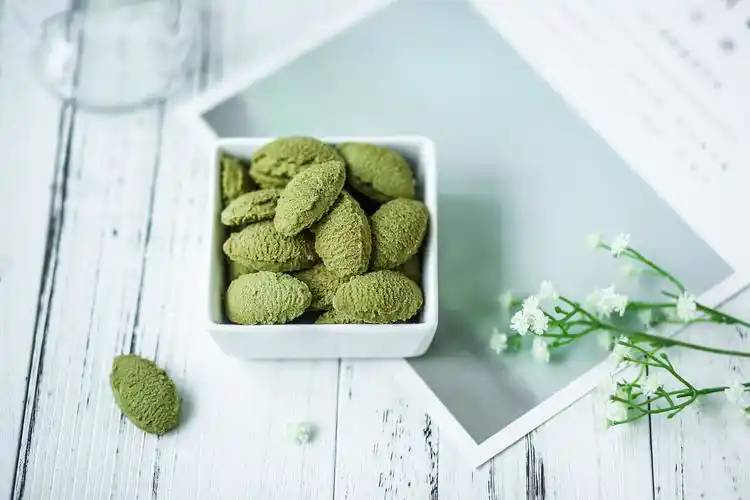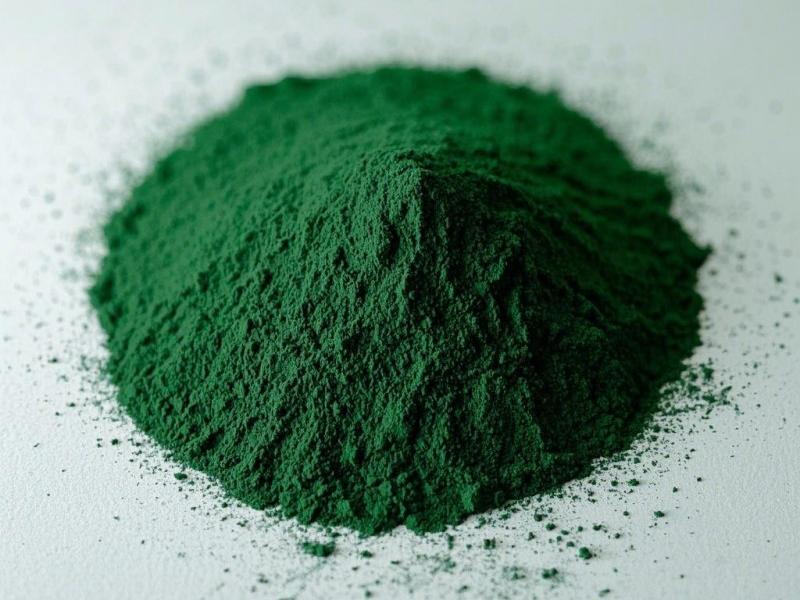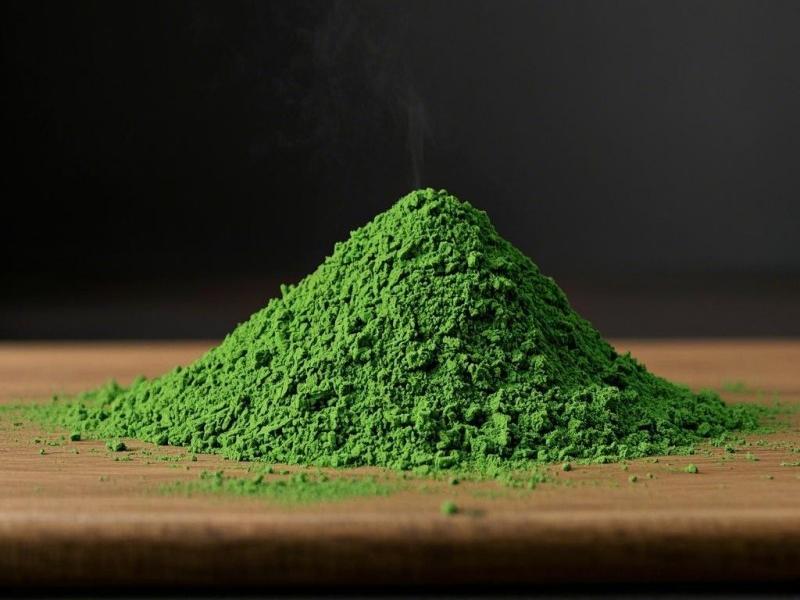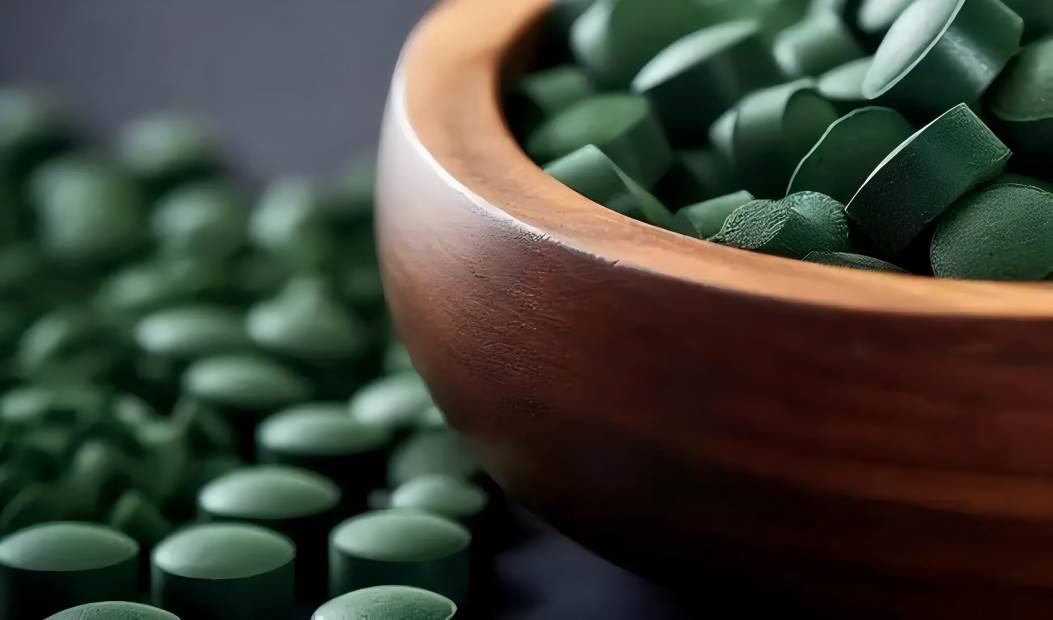Study on Spirulina and Sports Nutrition
Spirulina (SP) is a marine microalgae in the shape of a spiral. It is also known as blue-green algae. Spirulina is rich in protein, vitamins, unsaturated fatty acids, various trace elements and other nutrients. It is by far the nutrient with the richest and most balanced nutrients among animals and plants, and is most suitable for human needs. In recent years, spirulina has been widely used as a sports supplement for athletes, such as Olympic athletes from the UK, the US, Cuba, etc., as a daily product to enhance sports performance and restore physical strength. This article provides a theoretical basis for the biological mechanism of spirulina to improve sports performance by reviewing its nutritional composition and biological functions.
1. Nutritional composition of spirulina
Spirulina is by far the world's richest and most comprehensive natural food. It contains almost all the nutrients the human body needs and has been hailed by modern science as a “miniature nutrient bank”. Spirulina contains a variety of sugars needed by the organism, which can be quickly broken down during exercise to provide energy for the body. It also has a high protein content of 60% to 70%. Spirulina is also a low-fat food, with a total fat content of about 10% of the protein, but its fat composition is mainly unsaturated fatty acids, especially rich in essential fatty acids; spirulina is also high in vitamins, especially carotene, vitamin E and vitamin C, which have antioxidant effects; spirulina also contains taurine and metabolic enzymes; it is rich in minerals and trace elements, such as calcium, magnesium, sodium, potassium, phosphorus, iodine, selenium, iron, copper, etc.; spirulina contains about 13% -15% carbohydrates [1]. Therefore, spirulina is considered to be one of the most beneficial sources of nutrition for athletes.
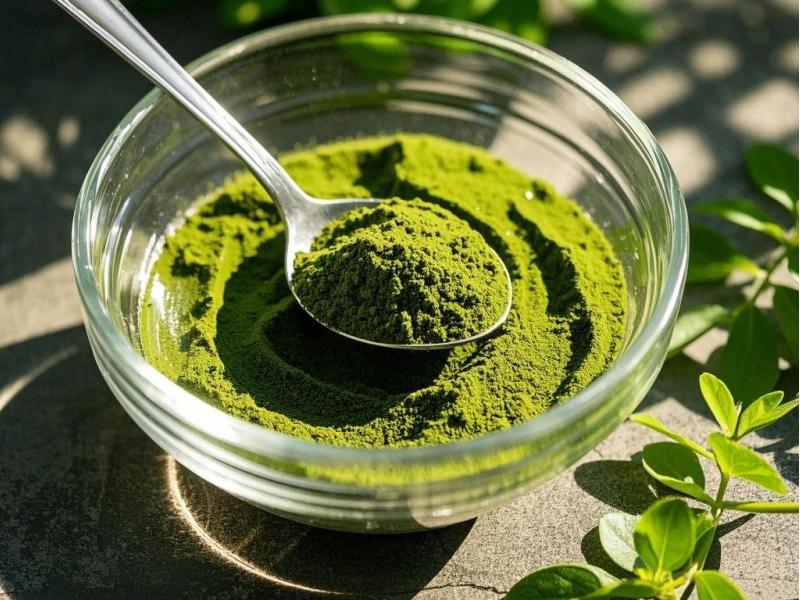
2. Biological functions of spirulina
2.1. Effect on immune function
Spirulina improves the body's stress and immune function by providing the body with substances necessary to maintain life activities and improving the metabolic capacity of cells. Spirulina is the plant in the food chain that is closest to animals, and its unique cell structure allows it to be directly absorbed by the human body. Spirulina contains a large amount of essential nutrients and physiologically active substances for the human body. And because its cell wall is composed of polysaccharides and does not contain cellulose, the absorption rate can be as high as 94%–95%. This is undoubtedly of practical significance for supplementing and balancing animal nutrition, strengthening the body, and improving the body's immune system. Spirulina can improve the phagocytic function of macrophages, promote the transformation of lymphocytes, increase the number of lymphocytes, and enhance their activity; it can increase the weight of the thymus and spleen; spirulina can promote serum protein synthesis and increase the content of serum lysozyme; spirulina polysaccharides can relieve the symptoms caused by immunosuppressants, such as atrophy of the thymus and spleen, reduction of T lymphocytes, and decrease of serum lysozyme in animals. Phycocyanin is a light-harvesting pigment complex protein with a very high content, accounting for about 20% of the dry weight.
Studies have shown that phycocyanin can enhance the activity of lymphocytes, improve the body's immune function through the lymphatic system, and comprehensively enhance the body's disease prevention and disease resistance. In addition, seaweed polysaccharide sulfates are natural heparin-like substances that can improve human immunity and have anti-tumor effects. Beta-carotene is one of the most effective free radical scavengers. It is found in spirulina at a level of 200 to 400 mg/100 g. Recent studies have found that beta-carotene has a significant antioxidant effect and can improve the body's immune system. It does this by destroying singlet oxygen and other forms of active oxygen, thereby promoting the strengthening of the immune system. This is mainly manifested in its ability to protect phagocytes from oxidative damage, promoting the proliferation of T and B lymphocytes, enhancing the function of T cells, and promoting the production of certain interleukins.
2. 2.Antioxidant effect
Spirulina powder is rich in nutrients and has strong antioxidant properties. Spirulina protein has a positive effect on the activity of the body's SOD enzyme, and significantly improves the activity of the body's SOD and GSH-Px, especially the liver's GSH-Px, which has a significant protective effect. Elevated SOD and GSH-Px activity has a very good protective effect on protecting cell membranes and preventing oxidation. Algin has the ability to remove free radicals, and spirulina polysaccharides have a strong affinity for OH, which reduces the chance of OH reacting with nucleic acids, lipids, amino acids, etc. indicating that spirulina polysaccharides have similar functions to endogenous free radical systems; β-carotene can quench singlet oxygen, triplet state photosensitizing substances and free radicals, thereby inhibiting lipid peroxidation; vitamin E is a very strong antioxidant that can quench free radicals in the body to protect cells from damage. Together with superoxide dismutase (SOD) and glutathione peroxidase (GSH-Px), it forms the body's antioxidant system, protecting the polyunsaturated fatty acids that make up biological membranes from free radical attacks and maintaining the integrity of the membrane. As an antioxidant, vitamin E also prevents the oxidation of vitamin A, vitamin C and ATP, ensuring their function in the body; selenium in spirulina is a component of glutathione peroxidase. In the body, selenium is used to catalyze the destruction of peroxides, hydrogen peroxide, etc. in the water-soluble part through GSH-Px. In addition, spirulina also contains trace elements such as iron, cobalt, and manganese, which also have good antioxidant effects and are also components of many important enzymes in the body.
2.3. Effects on red blood cells and hemoglobin
Changes in the morphology of red blood cells affect their oxygen-carrying function, leading to a decrease in exercise capacity, and also affect their deformability, leading to microcirculatory damage. In addition, changes in the morphology of red blood cells also affect their rheological properties, making them prone to get stuck in the reticuloendothelial system and be destroyed, and in severe cases, intravascular hemolysis occurs. Hemoglobin is an important carrier of oxygen and carbon dioxide in red blood cells. Changes in its content will affect the oxygen-carrying capacity of red blood cells, leading to exercise fatigue. Zhu Meiju [3] and others showed through animal experiments that spirulina and its compound can significantly reduce the abnormal rate of red blood cells in mice undergoing high-intensity training, which leads to abnormal red blood cell morphology, and have a significant protective effect on red blood cells. Another experiment showed [4] that athletes can increase the hemoglobin content in their blood after taking spirulina capsules orally, and that a certain dose of spirulina can significantly protect against the decrease in hemoglobin caused by artificial blood loss from the heart in rats.
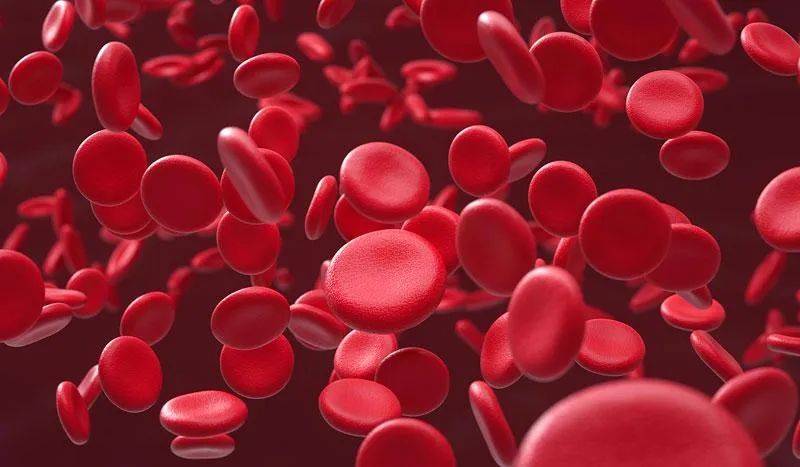
2.4. Effect on the occurrence of cardiovascular disease
Tests have shown that spirulina has the effect of lowering serum cholesterol [5]. Li Xianghong et al. concluded from a test investigating the effect of spirulina on the blood lipid levels of rats fed a high-fat diet that spirulina can lower the triglycerides (TG) and serum cholesterol (TC) in the serum of rats fed a high-fat diet, indicating that spirulina has an inhibitory effect on the increase in TG and TC in the serum induced by a high-fat diet [6]. In addition, spirulina is rich in linoleic acid and lambda-linolenic acid, which can be metabolized in the body to produce DHA and EPA, and are also precursors for synthesizing prostaglandins (PG). These substances have the effect of lowering blood lipids and cholesterol, reducing blood viscosity, improving tissue blood circulation, maintaining vascular elasticity, preventing arteriosclerosis and cardiovascular disease.
2.5. Effect on iron deficiency anemia
Spirulina is high in protein and also contains iron and vitamins. Spirulina is rich in iron, porphyrin-ring pigments and high-quality protein, which are the three main components of hemoglobin. When the body's hematopoietic system functions normally, the body will quickly be replenished with large amounts of new hemoglobin, thereby preventing the occurrence of iron deficiency anemia. Liang Jiangming et al. used a low-iron diet to replicate the iron deficiency anemia model, and then used spirulina to conduct a recovery test. The results showed that taking a certain amount of spirulina can speed up the recovery from iron deficiency anemia, promote iron absorption, and increase plasma protein levels [7]. Another experiment showed that using purebred rats to replicate the model of iron deficiency anemia, and then feeding them with 30 mg/kg ferrous sulfate and spirulina in three different doses mixed in the feed. The results showed that the hemoglobin, red blood cell count, cell volume, and serum protein in the three spirulina-fed groups increased significantly. Among them, the therapeutic efficacy of the two groups with more than 8% spirulina in the feed was the same as that of the ferrous sulfate treatment control group, while body weight recovery was better [8] (P370).
3. Spirulina and exercise capacity
The improvement of exercise capacity depends on factors such as the regulation and coordination of energy metabolism and acid-base balance. In terms of energy supply substances, such as the content of muscle glycogen and the rate of oxidation of fatty acids, have an important effect on the level of exercise. Spirulina is rich in nutrients and has a positive effect on improving exercise capacity and eliminating exercise fatigue.
3.1. Spirulina and blood lactate
Exercise can increase the amount of lactic acid in the muscles. When lactic acid increases, it will affect exercise capacity. The increase in lactic acid will cause the pH of the muscle tissue and blood to decrease, preventing the transmission of nerve muscle junction excitability, affecting the transmission of impulses to the muscles, inhibiting the activity of fructose phosphate kinase (PFK), thereby inhibiting glycolysis, and slowing the rate of ATP synthesis. In addition, the PH decreases, which also reduces the concentration of C a2+ in the sarcoplasm, thereby affecting the interaction between myosin and actin and weakening muscle contraction. Spirulina has the ability to reduce lactic acid and increase aerobic metabolism, and can significantly reduce the production of blood lactic acid after consumption. Some people have studied the effect of spirulina on blood lactic acid in mice at high temperatures and concluded that adding 0.5% spirulina, 0.1% L-A sp, 0.3% L-Tyr and 25% spirulina to the feed can significantly reduce the production of blood lactic acid and increase aerobic metabolism. In addition, spirulina, as an alkaline food, has the effect of neutralizing the acidic system under fatigue and maintaining the slightly alkaline physique of the human body, thereby achieving the purpose of anti-fatigue.
3.2. Spirulina and free radicals
The mechanism of exercise fatigue is a very complex process. The free radical theory is an important scientific basis for explaining the process of exercise fatigue. This theory holds that after a long period of heavy exercise, the increase in energy consumption in the body, the build-up of acidic substances and the enhanced oxidation caused by certain substances constantly produced during the metabolic process will all lead to an increase in the production of free radicals and enhanced lipid peroxidation, which will cause damage to the tissues and cells of the body and lead to exercise fatigue [10].
After prolonged exercise, athletes can experience increased lipid peroxidation in skeletal muscle mitochondria, increased production of oxidative free radicals, and decreased activity of the antioxidant enzyme SOD, resulting in damage to the function and structure of skeletal muscle. Huang Lixin found that spirulina can reduce the production of free radicals in the mitochondria of skeletal muscle and enhance the activity of antioxidant enzymes in rats after exhausting exercise by observing the effect of spirulina on the metabolism of free radicals and the marker enzymes of muscle damage after exhausting exercise. Spirulina can reduce the production of free radicals in the mitochondria of skeletal muscle, enhance the activity of antioxidant enzymes, and reduce the level of marker enzymes of muscle damage in the serum, indicating that spirulina has a significant protective effect on exercise-induced skeletal muscle damage [11]. Another experiment showed [12]: The RBC and SOD activity in the blood of athletes in the spirulina group were significantly higher at the end of the experiment than before the experiment, and significantly higher than the control group, while MDA was significantly lower than the control group, indicating that spirulina inhibits free radical oxidation in vivo, reduces lipid peroxidation, and helps prevent or delay fatigue.
Tang et al. found that spirulina and its compound can significantly increase the activity of erythrocyte SOD and reduce the content of malondialdehyde (MDA) in erythrocytes in exercised mice, suggesting that spirulina can protect cells by increasing the activity of antioxidant enzymes such as SOD, scavenging oxygen free radicals, and reducing the damage caused by oxygen free radicals and lipid peroxidation substances to the structure of red blood cell membranes [2]. Zhu Meiju et al. [13] showed through animal experiments that the exercise group of mice had low mitochondrial SOD activity and increased MDA content in the myocardium after exhaustive swimming, and that the dynamic balance between free radical production and scavenging was disrupted, resulting in oxidative damage.

The mitochondrial SOD activity of the single-herb group and compound group mice was higher than that of the exercise group (P<0.05 and P<0.01, respectively), MDA content was lower than that of the exercise group (both P<0.01); the SOD activity of the myocardium mitochondria of mice in the compound group was higher than that of the single-herb group, and the MDA content was lower than that of the single-herb group (both P<0.01), suggesting that both single-herb spirulina and spirulina compound can improve the SOD activity of the myocardium mitochondria of mice trained by swimming and reduce the MDA content, and the effect of the spirulina compound is significantly better than that of the single-herb spirulina.
3.3. Spirulina and exercise-induced anemia
Exercise-induced anemia is a common disease that endangers the health of athletes and affects their athletic ability, training results, and post-training recovery. Its occurrence is related to a variety of factors, such as an increase in relative blood volume, insufficient hemoglobin synthesis (excessive iron loss under exercise load, reduced iron absorption, and insufficient dietary iron supply), decreased red blood cell production, and increased destruction. In China, the rate of exercise-induced anemia is relatively high, and studies of relevant hematological indicators have revealed that iron deficiency anemia is the main type of exercise-induced anemia. For a long time, people have mainly used iron supplements and iron-fortified foods to prevent iron deficiency anemia, but because of the irritating effect of iron supplements on the gastrointestinal tract, the absorption and utilization rate is low.
In addition, iron supplements are easily oxidized by lipids in foods, which is not acceptable to patients. In recent years, the development and utilization of natural foods rich in iron has attracted the attention of nutritionists. Spirulina is not only high in protein, but also rich in iron (630 mg/kg dry powder). Treatment of iron deficiency anemia with spirulina has significant efficacy. Huang Lixin et al. also confirmed through a survey of 35 swimmers that spirulina can maintain the level of Hb iron reserves and effectively prevent the occurrence of exercise anemia [12]. In addition, studies have shown that spirulina can increase the concentration of red blood cells and hemoglobin in exercising rats and blood-loss mice, increase the activity of erythrocyte Na-K-ATPase, reduce the osmotic fragility of red blood cells, slow down the destruction of red blood cells, and effectively correct exercise anemia [14,15].
3.4. Effect on hemoglobin
When the body is exercising, tissues are in a state of varying degrees of ischemia and hypoxia. Increasing the hemoglobin level and accelerating the supply of oxygen are important factors in improving the body's exercise capacity. The level of hemoglobin affects the endurance of athletes and their athletic performance within a certain range. Spirulina has the effect of promoting hemoglobin growth, promoting the secretion of sex hormones, and improving sexual function. Zhu Xiaomei et al. observed the effect of spirulina on athletes' hemoglobin by giving them spirulina capsules directly. The results showed that the athletes' hemoglobin levels increased significantly after taking spirulina, especially for anemia caused by iron deficiency, which had a good therapeutic effect. Spirulina has the effect of promoting the secretion of sex hormones and can increase the level of testosterone in the body [16].
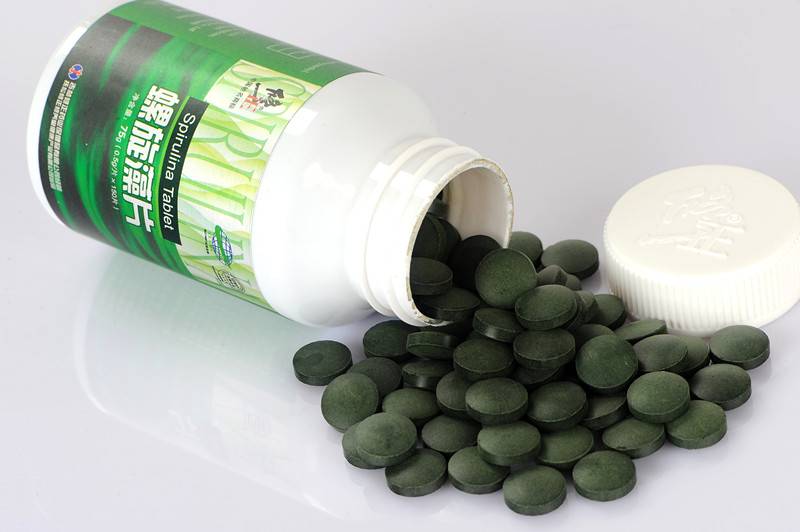
4. Summary
For athletes, the key to achieving good sporting results is to improve stamina and eliminate fatigue. Spirulina is a complete nutrient rich in high-quality, high-protein foods. It is rich in a complete range of amino acids, especially essential amino acids, which are easily digested and absorbed by the body, promote growth and effectively strengthen the body [17]. A moderate supply of vitamins B1, B2 and C can improve the sensitivity and endurance of the nervous system during exercise, improve athletic performance and alleviate adverse conditions [18]; rich in inorganic salts and trace elements, it can maintain the balance of water and salt metabolism in athletes, prevent the body fluids from becoming acidic or delay the onset of exercise-induced fatigue; the rich minerals can alkalize acidic blood to neutralize excessive lactic acid in the body, achieving the purpose of anti-fatigue; rich in aspartic acid, which has a direct anti-fatigue effect; rich in a variety of trace elements needed by the human body, such as copper and selenium, etc., and may also play a role in the lipid-lowering mechanism; spirulina has a significant antioxidant effect and corrects the metabolic imbalance of free radicals; it also has a significant protective effect on the heart muscle, skeletal muscle, liver, kidneys, etc.
Numerous studies have shown that spirulina has great development value as a sports supplement. As research continues, spirulina will attract more attention and is worthy of further study in the field of sports supplements, providing a basis for further development and utilization.
References
[1] Xiong Zhengying, Li Feng. The effect of spirulina supplementation on exercise capacity [J]. Hubei Sports Science and Technology, 2004, 23 (4): 454-456, 460.
[2] Tang Mei, Jin Ying, Guo Baojiang. The effect of spirulina protein on the immune function of mice [J]. Journal of Jinan University (Natural Science Edition), 1998, 19(5): 93-97.
[3] Zhu Meiju, Qu Julan, Li Hong. Effects of spirulina and its compound on red blood cells and free muscle metabolism in exercised mice [J]. Chinese Journal of Sports Medicine, 2003, 22(5): 506-508.
[4] Xu Rongxian, Liao Huizhen. A study on the nutritional intervention of spirulina capsules on juvenile sports school athletes [J]. Journal of Nutrition, 2000, 22 (2): 184-186.
[5] Fang Zhaoxi, Zhang Aiqin. Preliminary analysis of several components of spirulina [J]. Journal of Nutrition, 1989, 11 (2): 146-149.
[6] Li Xianghong, Yuan Xiuling, Wu Kaiguo, et al. Effect of spirulina on blood lipid levels in rats fed a high-fat diet [J]. Journal of Nutrition, 1996, 18(2): 206-208.
[7] Duan Qiyu, Liu Quan, Sun Xiuzhu. Trace elements and anti-aging [J]. Journal of Geriatric Medicine, 1987, 7(1): 60-63.
[8] Yu Shouyang, Cui Hongbin. Progress in the research of Chinese health foods [M]. Beijing: People's Publishing House, 2001.
[9] Luo Haiji, Ji Yanhong, Lu Xiaocui, et al. The effect of spirulina on blood lactate, blood urea and glycogen content at high temperatures [J]. Journal of Nutrition, 2000, 22 (1): 52-54.
[10] Cao Guohua, Chen Jidi. The effects of exercise, zinc and copper nutrition and free radical metabolism on the generation and scavenging of free radicals in the human body during acute aerobic or anaerobic exercise [J]. Chinese Journal of Sports Medicine, 1991, 10(1): 1-3.
[11] Huang Lixin, Lu Xiaochuan, Yang Bin, et al. Study on the protective effect of spirulina on rat motor skeletal muscle [J]. Sports Science, 2000, 20 (2): 58~ 59.
[12] Huang Lixin, Lu Xiaochuan, Gong Deqing, et al. Study on spirulina's resistance to exercise-induced anemia and improvement of exercise capacity [J]. Guangxi Sports Science and Technology, 1996, 17 (4): 25~29.
[13] Zhu Meiju, Li Hong. The protective effect of spirulina and its compound on myocardial mitochondrial peroxidation damage in exercised mice [J]. Chinese Journal of Sports Science and Technology, 2002, 38 (4): 37-38.
[14] Hu Long. Pharmacological and toxicological studies on spirulina capsules [J]. Traditional Chinese Medicine, 1995, 17 (7): 28-30.
[15] Pang Hui, Li Qianruo, Huang Lixin, et al. The effect of spirulina on red blood cells of exercising rats [J]. Journal of Guangxi Medical University, 1996, 13 (2): 47-49.
[16] Zhu Xiaomei, Yan Zheng. The effect of spirulina on biochemical indicators such as hemoglobin in athletes [J]. Sports Science, 1996, (6): 32-33.
[17] Cheng Shuangqi, Cao Shimin, Zheng Wei, et al. Nutritional evaluation of spirulina [J]. Journal of Nutrition, 1990, 12 (4): 416-417.
[18] Xu Rongxian, Xie Binglin, Lin Na, et al. The effect of nutritional intervention on the nutritional status of junior high school athletes [J]. Chinese Journal of Public Health, 1997, 13 (supplement): 41–43.


 English
English French
French Spanish
Spanish Russian
Russian Korean
Korean Japanese
Japanese